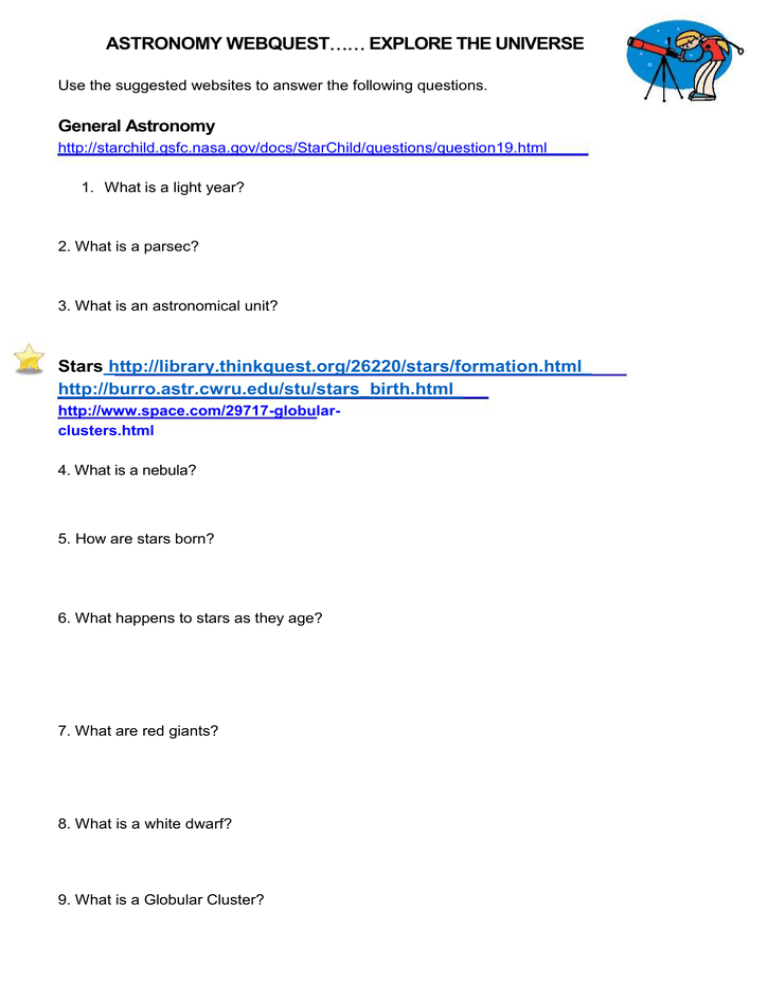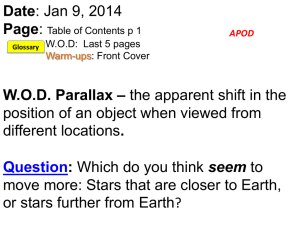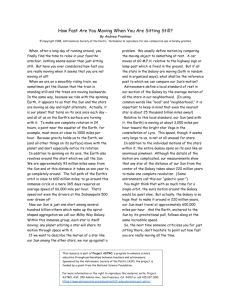Galaxy Webquest
advertisement

ASTRONOMY WEBQUEST EXPLORE THE UNIVERSE ! Use the suggested websites to answer the following questions. General Astronomy http://starchild.gsfc.nasa.gov/docs/StarChild/questions/question19.html 1. What is a light year? It's a unit of distance. It's the distance light can travel in one year. 2. What is a parsec? 3.26 light years 3. What is an astronomical unit? This is the distance between the Earth and the Sun (150, 000, 000 kilometers) Stars http://library.thinkquest.org/26220/stars/formation.html http://burro.astr.cwru.edu/stu/stars_birth.html http://www.space.com/29717-globularclusters.html 4. What is a nebula? A cloud of dust and gas 5. How are stars born? Stars are born in a nebula (interstellar clouds of dust and gas) 6. What happens to stars as they age? These young stars undergo further collapse, forming main sequence stars. 90% of a stars life remains in the main sequence which is where the star burns only hydrogen. Stars expand as they grow old. 7. What are red giants? A red giant is a relatively old star whose diameter is about 100 times bigger than it was originally, and had become cooler (the surface temperature is under 6,500 K). They are frequently orange in color. 8. What is a white dwarf? A white dwarf is a small, very dense, hot star that is made mostly of carbon. These remain after the red giant star loses its outer layer. 9. What is a Globular Cluster? Globular clusters are gravitationally bound concentrations of approximately ten thousand to one million stars 10. What is the relationship between Globular Clusters and the Milky Way? 11. Globular clusters make up the Milky Way. Lifecycle of a Star http://www.enchantedlearning.com/subjects/astronomy/stars/lifecycle/ http://btc.montana.edu/ceres/html/LifeCycle/starsbackground.htm http://www.windows.ucar.edu/tour/link=/the_universe/Nebula.html http://www.windows.ucar.edu/tour/link=/the_universe/Strange.html http://www.windows.ucar.edu/tour/link=/the_universe/Galaxy.html http://outreach.atnf.csiro.au/education/everyone/pulsars/ 12. Stars and planets are made from gases in a _ nebular (clouds of gas)___. The Milky Way Galaxy is approximately 100,000 or 150,0000 light years across. 13. How much longer will our Sun last? 5 billion years Lifetimes of stars range from 10,0000 to 100,000 years. 14. Our star orbits the centre of our galaxy about once every ________________ years. 15. A teaspoon of material from a neuron star can weigh about _____________________. 16. Stars are made mainly from what gases?____ and __Hydrogen_____. 17. Describe the stages of a star's life cycle in the correct order. Sun-like Stars (Mass under 1.5 times the mass of the Sun) --> Red Giant --> Planetary Nebula -->White Dwarf --> Black Dwarf Huge Stars (Mass between 1.5 to 3 times the mass of the Sun) --> Red SuperGiant --> Supernova --> Neutron Star Giant Stars (Mass over 3 times the mass of the Sun) --> Red SuperGiant --> Supernova --> Black Hole 18. What is a supernova? Stars don't last forever. Occasionally, a star bigger than our Sun will end its life in a huge explosion, called a supernova. 19. What are the possible end-products of a supernova? Formation of new stars or a blackhole 20. What is a pulsar? This type of neutron star is called a pulsar...Pulsars are detected by their rapidly repeating radio signals beemed at Earth from those charged particles trapped in the m 21. How is a pulsar formed? Universe http://starchild.gsfc.nasa.gov/docs/StarChild/universe_level2/universe.html 22. What is a black hole? Black holes are extremely compact space objects that were once massive stars which collapsed inward due to the force there gravity. 23. Quasar is short for Quasi-stellar 24. How much energy do quasars give off? Quasars give off more energy than 100 galaxies combined 25. What gives a star its light? A star is a brilliantly glowing sphere of hot gas whose energy is produced by an internal nuclear fusion process 26. Sketch 3 types of Galaxy. Indicate which one most closely resembles our galaxy. Irregular Galaxy Spiral Galaxy Elliptical Galaxy Milky Way Galaxy http://curious.astro.cornell.edu/milkyway.php#questions http://www.efn.org/~jack_v/Universe.html http://cass.ucsd.edu/public/tutorial/mw.html http://science.howstuffworks.com/dictionary/astronomy-terms/milky-way.htm 27. Describe our Galaxy (The Milky Way Galaxy) and its structure. 28. What is the Earth's place in our Galaxy? We live on the third plant from the sun at a distance of 8.3 light minutes (150 million kilometres or 93 million miles) 29. How many stars make up the Milky Way Galaxy? 250 billion stars 30. How old is our galaxy? 1315 billion years old 31. What shape is the Milky Way? Spiral Galaxy 32. Describe the Milky Way and our galactic neighborhood. Sister Galaxy: The largest galaxy in our group is called the Andromeda Spiral. A large spiral similar to the Milky Way. It is about 2.3 million light years from Earth and contains about 400 billion stars. Closest Star: Alpha Proxima is our nearest neighboring star: 4.3 light years away. . 33. What role does gravity play in our galaxy and universe? Laws of Motion and the movement of planets/satellites http://spaceplace.nasa.gov/en/kids/phonedrmarc/2002_july.shtml 34. Describe the motion of our planets (Newton). 35. Read the following background articles and describe how the universe began, and how galaxies merge and collide. http://www.space.com/scienceastronomy/051212_mystery_monday.html http://www.space.com/scienceastronomy/merging_backhole_021119.html http://www.space.com/scienceastronomy/astronomy/spongy_universe_010522-1.html









